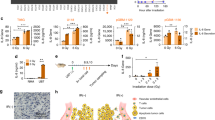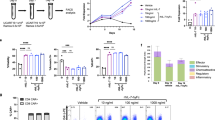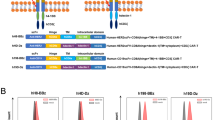Abstract
Chimeric antigen receptor (CAR) T-cell immunotherapies have shown unprecedented success in treating leukemia but limited clinical efficacy in solid tumors. Here, we generated 1928zT2 and m28zT2, targeting CD19 and mesothelin, respectively, by introducing the Toll/interleukin-1 receptor domain of Toll-like receptor 2 (TLR2) to 1928z and m28z. T cells expressing 1928zT2 or m28zT2 showed improved expansion, persistency and effector function against CD19+ leukemia or mesothelin+ solid tumors respectively in vitro and in vivo. In a patient with relapsed B-cell acute lymphoblastic leukemia, a single dose of 5 × 104/kg 1928zT2 T cells resulted in robust expansion and leukemia eradication and led to complete remission. Hence, our results demonstrate that TLR2 signaling can contribute to the efficacy of CAR T cells. Further clinical trials are warranted to establish the safety and efficacy of this approach.
This is a preview of subscription content, access via your institution
Access options
Subscribe to this journal
Receive 12 print issues and online access
$259.00 per year
only $21.58 per issue
Buy this article
- Purchase on Springer Link
- Instant access to full article PDF
Prices may be subject to local taxes which are calculated during checkout





Similar content being viewed by others
References
Hombach A, Abken H . Costimulation tunes tumor-specific activation of redirected T cells in adoptive immunotherapy. Cancer Immunol Immunother 2007; 56: 731–737.
Kowolik CM, Topp MS, Gonzalez S, Pfeiffer T, Olivares S, Gonzalez N et al. CD28 costimulation provided through a CD19-specific chimeric antigen receptor enhances in vivo persistence and antitumor efficacy of adoptively transferred T cells. Cancer Res 2006; 66: 10995–11004.
Milone MC, Fish JD, Carpenito C, Carroll RG, Binder GK, Teachey D et al. Chimeric receptors containing CD137 signal transduction domains mediate enhanced survival of T cells and increased antileukemic efficacy in vivo. Mol Ther 2009; 17: 1453–1464.
Long AH, Haso WM, Shern JF, Wanhainen KM, Murgai M, Ingaramo M et al. 4-1BB costimulation ameliorates T cell exhaustion induced by tonic signaling of chimeric antigen receptors. Nat Med 2015; 21: 581–590.
Pule MA, Straathof KC, Dotti G, Heslop HE, Rooney CM, Brenner MK . A chimeric T cell antigen receptor that augments cytokine release and supports clonal expansion of primary human T cells. Mol Ther 2005; 12: 933–941.
Song DG, Ye Q, Poussin M, Harms GM, Figini M, Powell DJ Jr . CD27 costimulation augments the survival and antitumor activity of redirected human T cells in vivo. Blood 2012; 119: 696–706.
Shen CJ, Yang YX, Han EQ, Cao N, Wang YF, Wang Y et al. Chimeric antigen receptor containing ICOS signaling domain mediates specific and efficient antitumor effect of T cells against EGFRvIII expressing glioma. J Hematol Oncol 2013; 6: 33.
Zhang BL, Qin DY, Mo ZM, Li Y, Wei W, Wang YS et al. Hurdles of CAR-T cell-based cancer immunotherapy directed against solid tumors. Sci China Life sci 2016; 59: 340–348.
Brown CE, Alizadeh D, Starr R, Weng L, Wagner JR, Naranjo A et al. Regression of glioblastoma after chimeric antigen receptor T-cell therapy. N Engl J Med 2016; 375: 2561–2569.
Komai-Koma M, Jones L, Ogg GS, Xu DM, Liew FY . TLR2 is expressed on activated T cells as a costimulatory receptor. Proc Natl Acad Sci USA 2004; 101: 3029–3034.
Cottalorda A, Mercier BC, Mbitikon-Kobo FM, Arpin C, Teoh DY, McMichael A et al. TLR2 engagement on memory CD8(+) T cells improves their cytokine-mediated proliferation and IFN-gamma secretion in the absence of Ag. Eur J Immunol 2009; 39: 2673–2681.
Sinnott BD, Park B, Boer MC, Lewinsohn DA, Lancioni CL . Direct TLR-2 costimulation unmasks the proinflammatory potential of neonatal CD4+ T cells. J Immunol 2016; 197: 68–77.
Salerno F, Guislain A, Cansever D, Wolkers MC . TLR-mediated innate production of IFN-gamma by CD8+ T cells is independent of glycolysis. J Immunol 2016; 196: 3695–3705.
Cottalorda A, Verschelde C, Marcais A, Tomkowiak M, Musette P, Uematsu S et al. TLR2 engagement on CD8 T cells lowers the threshold for optimal antigen-induced T cell activation. Eur J Immunol 2006; 36: 1684–1693.
Mercier BC, Cottalorda A, Coupet CA, Marvel J, Bonnefoy-Berard N . TLR2 engagement on CD8 T cells enables generation of functional memory cells in response to a suboptimal TCR signal. J Immunol 2009; 182: 1860–1867.
Quigley M, Martinez J, Huang X, Yang Y . A critical role for direct TLR2-MyD88 signaling in CD8 T-cell clonal expansion and memory formation following vaccinia viral infection. Blood 2009; 113: 2256–2264.
Imanishi T, Hara H, Suzuki S, Suzuki N, Akira S, Saito T et al. TLR2 directly triggers Th1 effector functions. J Immunol 2007; 178: 6715–6719.
Oberg HH, Ly TT, Ussat S, Meyer T, Kabelitz D, Wesch D . Differential but direct abolishment of human regulatory T cell suppressive capacity by various TLR2 ligands. J Immunol 2010; 184: 4733–4740.
Babu S, Blauvelt CP, Kumaraswami V, Nutman TB . Cutting edge: diminished T cell TLR expression and function modulates the immune response in human filarial infection. J Immunol 2006; 176: 3885–3889.
Zhang Y, Luo F, Cai Y, Liu N, Wang L, Xu D et al. TLR1/TLR2 agonist induces tumor regression by reciprocal modulation of effector and regulatory T cells. J Immunol 2011; 186: 1963–1969.
Zhang Y, Luo F, Li A, Qian J, Yao Z, Feng X et al. Systemic injection of TLR1/2 agonist improves adoptive antigen-specific T cell therapy in glioma-bearing mice. Clin Immunol 2014; 154: 26–36.
Sandor F, Latz E, Re F, Mandell L, Repik G, Golenbock DT et al. Importance of extra- and intracellular domains of TLR1 and TLR2 in NFkappa B signaling. J Cell Biol 2003; 162: 1099–1110.
O'Neill LA, Bowie AG . The family of five: TIR-domain-containing adaptors in Toll-like receptor signalling. Nat Rev Immunol 2007; 7: 353–364.
Brown V, Brown RA, Ozinsky A, Hesselberth JR, Fields S . Binding specificity of Toll-like receptor cytoplasmic domains. Eur J Immunol 2006; 36: 742–753.
Brentjens RJ, Davila ML, Riviere I, Park J, Wang X, Cowell LG et al. CD19-targeted T cells rapidly induce molecular remissions in adults with chemotherapy-refractory acute lymphoblastic leukemia. Sci Transl Med 2013; 5: 177ra138.
Davila ML, Riviere I, Wang X, Bartido S, Park J, Curran K et al. Efficacy and toxicity management of 19-28z CAR T cell therapy in B cell acute lymphoblastic leukemia. Sci Transl Med 2014; 6: 224ra225.
Grupp SA, Kalos M, Barrett D, Aplenc R, Porter DL, Rheingold SR et al. Chimeric antigen receptor-modified T cells for acute lymphoid leukemia. N Engl J Med 2013; 368: 1509–1518.
Kochenderfer JN, Dudley ME, Carpenter RO, Kassim SH, Rose JJ, Telford WG et al. Donor-derived CD19-targeted T cells cause regression of malignancy persisting after allogeneic hematopoietic stem cell transplantation. Blood 2013; 122: 4129–4139.
Maude SL, Frey N, Shaw PA, Aplenc R, Barrett DM, Bunin NJ et al. Chimeric antigen receptor T cells for sustained remissions in leukemia. N Engl J Med 2014; 371: 1507–1517.
Porter DL, Levine BL, Kalos M, Bagg A, June CH . Chimeric antigen receptor-modified T cells in chronic lymphoid leukemia. N Engl J Med 2011; 365: 725–733.
Dobrovolskaia MA, Medvedev AE, Thomas KE, Cuesta N, Toshchakov V, Ren T et al. Induction of in vitro reprogramming by Toll-like receptor (TLR)2 and TLR4 agonists in murine macrophages: effects of TLR ‘homotolerance’ versus ‘heterotolerance’ on NF-kappa B signaling pathway components. J Immunol 2003; 170: 508–519.
Ye W, Jiang Z, Li GX, Xiao Y, Lin S, Lai Y et al. Quantitative evaluation of the immunodeficiency of a mouse strain by tumor engraftments. J Hematol Oncol 2015; 8: 59.
Geng D, Zheng L, Srivastava R, Asprodites N, Velasco-Gonzalez C, Davila E . When Toll-like receptor and T-cell receptor signals collide: a mechanism for enhanced CD8 T-cell effector function. Blood 2010; 116: 3494–3504.
Boussif O, Lezoualc'h F, Zanta MA, Mergny MD, Scherman D, Demeneix B et al. A versatile vector for gene and oligonucleotide transfer into cells in culture and in vivo: polyethylenimine. Proc Natl Acad Sci USA 1995; 92: 7297–7301.
Ye W, Jiang Z, Li GX, Xiao Y, Lin S, Lai Y et al. Quantitative evaluation of the immunodeficiency of a mouse strain by tumor engraftments. J Hematol Oncol 2015; 8: 59.
Ho M, Bera TK, Willingham MC, Onda M, Hassan R, FitzGerald D et al. Mesothelin expression in human lung cancer. Clin Cancer Res 2007; 13: 1571–1575.
Lee DW, Kochenderfer JN, Stetler-Stevenson M, Cui YK, Delbrook C, Feldman SA et al. T cells expressing CD19 chimeric antigen receptors for acute lymphoblastic leukaemia in children and young adults: a phase 1 dose-escalation trial. Lancet 2015; 385: 517–528.
Park JH, Geyer MB, Brentjens RJ . CD19-targeted CAR T-cell therapeutics for hematologic malignancies: interpreting clinical outcomes to date. Blood 2016; 127: 3312–3320.
Lim WA, June CH . The principles of engineering immune cells to treat cancer. Cell 2017; 168: 724–740.
Sevko A, Umansky V . Myeloid-derived suppressor cells interact with tumors in terms of myelopoiesis, tumorigenesis and immunosuppression: thick as thieves. J Cancer 2013; 4: 3–11.
Ortiz ML, Lu L, Ramachandran I, Gabrilovich DI . Myeloid-derived suppressor cells in the development of lung cancer. Cancer Immunol Res 2014; 2: 50–58.
Ostrand-Rosenberg S, Sinha P, Figley C, Long R, Park D, Carter D et al. Frontline Science: myeloid-derived suppressor cells (MDSCs) facilitate maternal-fetal tolerance in mice. J Leukoc Biol 2017; 101: 1091–1101.
Zhao H, Kalish F, Schulz S, Yang Y, Wong RJ, Stevenson DK . Unique roles of infiltrating myeloid cells in the murine uterus during early to midpregnancy. J Immunol 2015; 194: 3713–3722.
Umansky V, Blattner C, Gebhardt C, Utikal J . The role of myeloid-derived suppressor cells (MDSC) in cancer progression. Vaccines 2016; 4: pii: E36.
Acknowledgements
We sincerely thank Dr Robert Weinkove at Malaghan Institute of Medical Research for his help in revising the manuscript. This study was supported by National Natural Science Foundation of China (81522002), the Strategic Priority Research Program of the Chinese Academy of Sciences (XDB19030205), the Natural Science Fund for Distinguished Young Scholars of Guangdong Province (2014A030306028), the Guangdong Provincial Applied Science and Technology Research& Development Program (2016B020237006), the Guangdong Provincial Outstanding Young Scholars Award (2014TQ01R068), the Frontier and key technology innovation special grant from the Department of Science and Technology of Guangdong province, (2015B020227003, 2014B020225005, 2016B030229006), the Guangdong Provincial Research and Commercialization Program (2014B090901044), and the Guangzhou Science Technology and Innovation Commission Project (201504010016). A patent application has been filed for the TLR2 incorporated CAR vector, and PL and YL are listed as authors on this application. The clinical trial is being sponsored by Guangdong Zhaotai Invivo Biomedicine Co. Ltd. and Hunan Zhaotai Yongren Medical Innovation Ltd.
Author information
Authors and Affiliations
Corresponding authors
Ethics declarations
Competing interests
The authors declare no conflict of interest.
Additional information
Supplementary Information accompanies this paper on the Leukemia website
Rights and permissions
About this article
Cite this article
Lai, Y., Weng, J., Wei, X. et al. Toll-like receptor 2 costimulation potentiates the antitumor efficacy of CAR T Cells. Leukemia 32, 801–808 (2018). https://doi.org/10.1038/leu.2017.249
Received:
Revised:
Accepted:
Published:
Issue Date:
DOI: https://doi.org/10.1038/leu.2017.249
This article is cited by
-
Acute myeloid leukemia: from NGS, through scRNA-seq, to CAR-T. dissect cancer heterogeneity and tailor the treatment
Journal of Experimental & Clinical Cancer Research (2023)
-
Distinct functions of CAR-T cells possessing a dectin-1 intracellular signaling domain
Gene Therapy (2023)
-
Strategies to enhance CAR-T persistence
Biomarker Research (2022)
-
CAR-T cell potency: from structural elements to vector backbone components
Biomarker Research (2022)
-
CXCL9-modified CAR T cells improve immune cell infiltration and antitumor efficacy
Cancer Immunology, Immunotherapy (2022)



